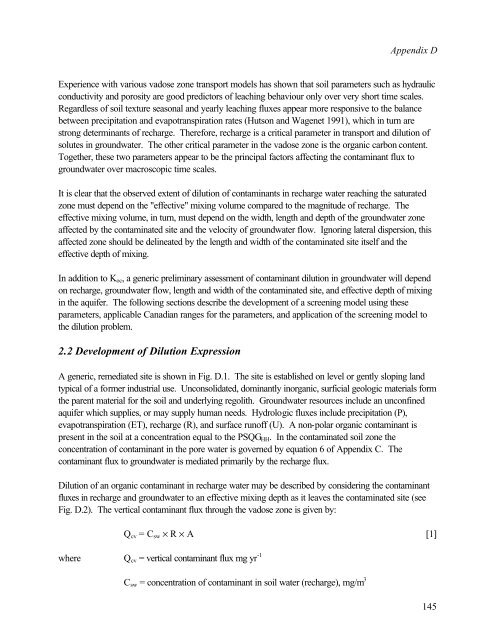Protocol for the Derivation of Environmental and Human ... - CCME
Protocol for the Derivation of Environmental and Human ... - CCME
Protocol for the Derivation of Environmental and Human ... - CCME
You also want an ePaper? Increase the reach of your titles
YUMPU automatically turns print PDFs into web optimized ePapers that Google loves.
Appendix D<br />
Experience with various vadose zone transport models has shown that soil parameters such as hydraulic<br />
conductivity <strong>and</strong> porosity are good predictors <strong>of</strong> leaching behaviour only over very short time scales.<br />
Regardless <strong>of</strong> soil texture seasonal <strong>and</strong> yearly leaching fluxes appear more responsive to <strong>the</strong> balance<br />
between precipitation <strong>and</strong> evapotranspiration rates (Hutson <strong>and</strong> Wagenet 1991), which in turn are<br />
strong determinants <strong>of</strong> recharge. There<strong>for</strong>e, recharge is a critical parameter in transport <strong>and</strong> dilution <strong>of</strong><br />
solutes in groundwater. The o<strong>the</strong>r critical parameter in <strong>the</strong> vadose zone is <strong>the</strong> organic carbon content.<br />
Toge<strong>the</strong>r, <strong>the</strong>se two parameters appear to be <strong>the</strong> principal factors affecting <strong>the</strong> contaminant flux to<br />
groundwater over macroscopic time scales.<br />
It is clear that <strong>the</strong> observed extent <strong>of</strong> dilution <strong>of</strong> contaminants in recharge water reaching <strong>the</strong> saturated<br />
zone must depend on <strong>the</strong> "effective" mixing volume compared to <strong>the</strong> magnitude <strong>of</strong> recharge. The<br />
effective mixing volume, in turn, must depend on <strong>the</strong> width, length <strong>and</strong> depth <strong>of</strong> <strong>the</strong> groundwater zone<br />
affected by <strong>the</strong> contaminated site <strong>and</strong> <strong>the</strong> velocity <strong>of</strong> groundwater flow. Ignoring lateral dispersion, this<br />
affected zone should be delineated by <strong>the</strong> length <strong>and</strong> width <strong>of</strong> <strong>the</strong> contaminated site itself <strong>and</strong> <strong>the</strong><br />
effective depth <strong>of</strong> mixing.<br />
In addition to K oc , a generic preliminary assessment <strong>of</strong> contaminant dilution in groundwater will depend<br />
on recharge, groundwater flow, length <strong>and</strong> width <strong>of</strong> <strong>the</strong> contaminated site, <strong>and</strong> effective depth <strong>of</strong> mixing<br />
in <strong>the</strong> aquifer. The following sections describe <strong>the</strong> development <strong>of</strong> a screening model using <strong>the</strong>se<br />
parameters, applicable Canadian ranges <strong>for</strong> <strong>the</strong> parameters, <strong>and</strong> application <strong>of</strong> <strong>the</strong> screening model to<br />
<strong>the</strong> dilution problem.<br />
2.2 Development <strong>of</strong> Dilution Expression<br />
A generic, remediated site is shown in Fig. D.1. The site is established on level or gently sloping l<strong>and</strong><br />
typical <strong>of</strong> a <strong>for</strong>mer industrial use. Unconsolidated, dominantly inorganic, surficial geologic materials <strong>for</strong>m<br />
<strong>the</strong> parent material <strong>for</strong> <strong>the</strong> soil <strong>and</strong> underlying regolith. Groundwater resources include an unconfined<br />
aquifer which supplies, or may supply human needs. Hydrologic fluxes include precipitation (P),<br />
evapotranspiration (ET), recharge (R), <strong>and</strong> surface run<strong>of</strong>f (U). A non-polar organic contaminant is<br />
present in <strong>the</strong> soil at a concentration equal to <strong>the</strong> PSQG HH . In <strong>the</strong> contaminated soil zone <strong>the</strong><br />
concentration <strong>of</strong> contaminant in <strong>the</strong> pore water is governed by equation 6 <strong>of</strong> Appendix C. The<br />
contaminant flux to groundwater is mediated primarily by <strong>the</strong> recharge flux.<br />
Dilution <strong>of</strong> an organic contaminant in recharge water may be described by considering <strong>the</strong> contaminant<br />
fluxes in recharge <strong>and</strong> groundwater to an effective mixing depth as it leaves <strong>the</strong> contaminated site (see<br />
Fig. D.2). The vertical contaminant flux through <strong>the</strong> vadose zone is given by:<br />
Q cv = C sw × R × A [1]<br />
where Q cv = vertical contaminant flux mg yr -1<br />
C sw = concentration <strong>of</strong> contaminant in soil water (recharge), mg/m 3<br />
145
















